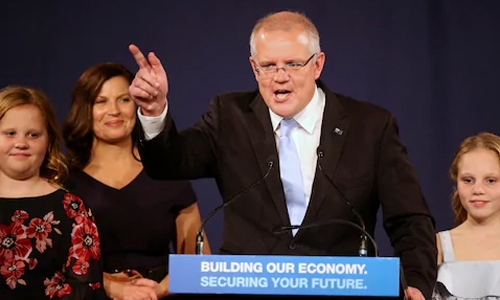Australia isn’t right-wing, it’s cautious
Ahead of Australia’s general election on Saturday, one party had campaigned on the idea that politics and the economy were rigged in favor of the elites. It attacked its opponent relentlessly for siding with the “top end of town.” It insisted that things needed to be shaken up to stop serving multinational corporations and vested interests. That party lost. The results were surprising.
The centre-right coalition, led by Prime Minister Scott Morrison, remained in power against the opposition Labour party, which had led in every poll for years. But aside from being an upset, the election shared little in common with Donald Trump’s 2016 victory, the Brexit referendum or other populist insurgencies around the world. This was a campaign in which the politics of race, xenophobia and immigration played almost no part. (That’s probably because of the atmosphere after terrorist attacks in Christchurch, New Zealand, in March.)
There was nothing in Morrison’s election pitch, perhaps other than continued support for coal mining, that seemed particularly aimed at rousing right-wing voters. Even on climate change, a major election issue on which there was some distance between the parties, Morrison argued his party was acting sufficiently — not dismissing it as some elite conspiracy. No, the lesson from Australia’s election isn’t that this country is right-wing but that it’s conservative — as in cautious. You could, if you were being unkind, call Labour’s platform populist.
And in fairness, the moment seemed right for its agenda: A royal commission into Australia’s banks recently revealed all manner of unethical practices and underwrote a public sense of disgust at corporate lawlessness. Stagnating wages following the decline of a mining boom have meant that many Australians are facing financial stress. House prices in the biggest cities have galloped wildly out of reach of many would-be first-time buyers. To address these very real economic concerns, Labour put forward serious, bold policies on complex issues that it argued overwhelmingly benefit the wealthy, in particular tax breaks on investment properties and retirees’ stock market dividends.
It was probably the most ambitious set of reforms any party has taken to an election in a generation. The coalition contrived to run without a significant policy agenda beyond offering tax cuts. Overwhelmingly, its campaign was a negative one, attacking Labour’s platform as reckless and anti-aspirational. But this wasn’t a populist message, either. In fact it’s a message of contentedness and caution. Its fundamental assumption is that broadly speaking, the system works fine: Trickle-down economics brings prosperity, and to the extent things could be better, such as wages, the answer is patience and more of the same. Labour couldn’t be trusted precisely because it wanted to shake things up.
That this argument delivered the coalition a stunning victory in what appeared to be an unwinnable election does not represent some new Australian political logic. Rather, it follows a well-established tradition and conventional wisdom: The Australian electorate is averse to big change. It is no coincidence that the last time an opposition attempted a policy platform this bold was in 1993 and the result was the same, only with the parties reversed. At that time, Labour was in government, and the coalition managed to lose what is frequently described as “the unlosable election.”
It is also no coincidence that Labour, which is Australia’s party of reform, has been in power for only 29 of Australia’s 74 postwar years. It also tends to come to power when a moment of crisis is brewing: world wars, the Great Depression, the global financial crisis. In ordinary times, Australia votes for mild, slow change. Usually that gives power to the coalition, but even the coalition tests Australia’s conservative temperament at its peril. The last time it lost power was in 2007 when it undertook sweeping labour reforms, which amounted to a significant attack on workers’ rights and tilted the power balance hugely in favour of employers. Labour’s problem this time proved to be that it tried too many big ideas at once.
Thus did Labour lose significantly in outer suburbs, including among several lower-income electorates. Perhaps the most underappreciated predictor here seems to be debt: Those seats that are experiencing heavy mortgage stress almost entirely swung sharply against Labour. That suggests that even though those voters might be financially stretched, they were spooked by Labour’s proposed changes to tax policy, which were subject to a scare campaign warning that they would cause house prices to collapse.
Perhaps that might have been countered had Labour run a better, more focused campaign. That post-mortem is now underway. Even so, the fact that Labour’s narrative of “fairness” failed before the coalition’s story of “aspiration” suggests Australia has not called time on neoliberalism in the way that voters elsewhere seem ready to. Certainly there is disillusionment, evidenced by a record vote for minor parties and independents.
But ultimately, 27 years of economic growth and only six years of wage stagnation (rather than the decades of it in the United States) mean that while scepticism of the corporate world and trepidation about the economy exists, Australia isn’t prepared to experiment with its economic formula just yet. Australians may not be entirely happy with the status quo, but they are clearly still prepared to vote for it.
Related Posts

